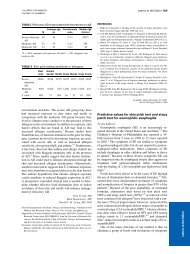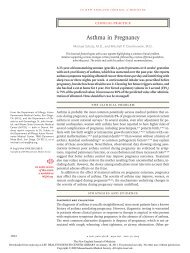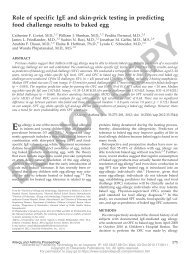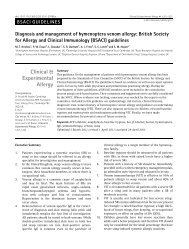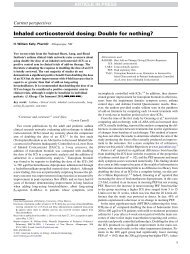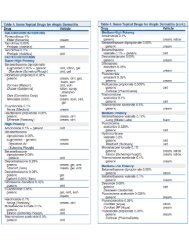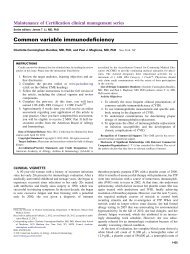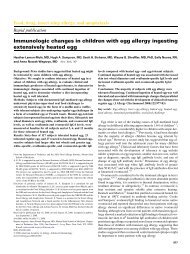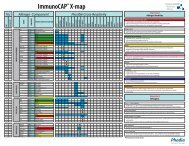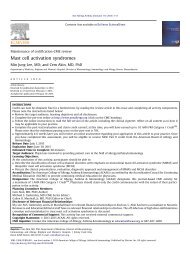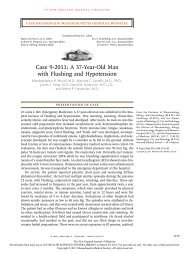Streptococcal Pharyngitis - NEJM 2011.pdf - AInotes
Streptococcal Pharyngitis - NEJM 2011.pdf - AInotes
Streptococcal Pharyngitis - NEJM 2011.pdf - AInotes
Create successful ePaper yourself
Turn your PDF publications into a flip-book with our unique Google optimized e-Paper software.
The new england journal of medicineclinical practice<strong>Streptococcal</strong> <strong>Pharyngitis</strong>Michael R. Wessels, M.D.This Journal feature begins with a case vignette highlighting a common clinical problem.Evidence supporting various strategies is then presented, followed by a review of formal guidelines,when they exist. The article ends with the author’s clinical recommendations.A 10-year-old girl presents with a sore throat and fever that has lasted for 1 day. Sheappears flushed and moderately ill. Physical examination reveals a temperature of39°C, tender bilateral anterior cervical lymph nodes that are 1 to 2 cm in the greatestdimension, and erythema and whitish-yellow exudate over enlarged tonsils and theposterior pharynx. A rapid antigen-detection test from a throat-swab specimen ispositive for group A streptococcus. How should the patient be evaluated and treated?The Clinical ProblemFrom the Division of Infectious Diseases,Children’s Hospital Boston and HarvardMedical School, Boston. Address reprintrequests to Dr. Wessels at the Division ofInfectious Diseases, Children’s HospitalBoston, 300 Longwood Ave., Boston, MA02115, or at michael.wessels@childrens.harvard.edu.N Engl J Med 2011;364:648-55.Copyright © 2011 Massachusetts Medical Society.An audio versionof this articleis available at<strong>NEJM</strong>.orgSore throat is an extremely common presenting symptom. Acute pharyngitis accountsfor 1.3% of outpatient visits to health care providers in the United States, and it accountedfor an estimated 15 million patient visits in 2006. 1 Group A streptococcus(Streptococcus pyogenes) is responsible for 5 to 15% of cases of pharyngitis in adults and20 to 30% of cases in children. 2 <strong>Streptococcal</strong> pharyngitis occurs most commonlyamong children between 5 and 15 years of age. In temperate climates, the incidenceis highest in winter and early spring. The economic burden of streptococcal pharyngitisamong children in the United States has been estimated at $224 million to$539 million per year, with a substantial fraction of the associated costs attributableto parents’ lost time from work. 3<strong>Streptococcal</strong> pharyngeal infection not only causes acute illness but also can triggerthe postinfectious syndromes of poststreptococcal glomerulonephritis and acuterheumatic fever. Rheumatic fever is currently uncommon in most developed countries,but it remains the leading cause of acquired heart disease among children in manyresource-poor areas such as sub-Saharan Africa, India, and parts of Australasia. 4Strategies and EvidenceEvaluationThe onset of symptoms in patients with streptococcal pharyngitis is often abrupt.In addition to throat pain, symptoms may include fever, chills, malaise, headache,and particularly in younger children abdominal pain, nausea, and vomiting. 5 Occasionally,streptococcal pharyngitis is accompanied by scarlet fever, which is manifestedas a finely papular erythematous rash that spares the face, may be accentuatedin skin folds, and may desquamate during convalescence. Cough, coryza, and conjunctivitisare not typical symptoms of streptococcal pharyngitis, and, if present,they suggest an alternative cause such as a viral infection. Throat pain may be severe,and it is often worse on one side. However, severe unilateral pain or an inability toswallow should raise concern about a local suppurative complication such as peritonsillaror retropharyngeal abscess, particularly if these symptoms arise or progressseveral days into the illness. Among children younger than 3 years of age, exudativepharyngitis due to streptococcal infection is rare. In this age group, streptococcal648n engl j med 364;7 nejm.org february 17, 2011The New England Journal of MedicineDownloaded from nejm.org by Ari Kounavis on April 28, 2011. For personal use only. No other uses without permission.Copyright © 2011 Massachusetts Medical Society. All rights reserved.
clinical practiceinfection may be manifested as coryza, excoriatednares, and generalized adenopathy. 5 In mostpersons, fever resolves within 3 to 5 days, andthroat pain resolves within 1 week, even withoutspecific treatment. 6,7The diagnosis of streptococcal pharyngitis onclinical grounds is notoriously unreliable. 8,9 Symptomsand signs are variable, and the severity ofillness ranges from mild throat discomfort aloneto classic exudative pharyngitis with high feverand prostration. The diagnosis is further complicatedby the fact that infection due to many otheragents may be indistinguishable clinically fromstreptococcal pharyngitis (Table 1).Clinical scoring systems have been developed topredict the likelihood of streptococcal infectionamong children and adults presenting with sorethroat. These systems are based on assessment forsuggestive clinical findings: fever, tonsillar swellingor exudate, tender and enlarged anterior cervicallymph nodes, and the absence of cough. Theprobability of positive results of a throat cultureor a rapid antigen-detection test ranges from 3% orless in patients with no suggestive clinical criteriato approximately 30 to 50% in those with allof them 8,10-12 (Table 2). Clinical prediction rulesbased on these criteria have been validated in bothadults and children to help identify patients inwhom evaluation with a throat culture or rapidantigen-detection test is warranted. 10 For example,in the absence of particular risk factors, suchas known exposure to a person with streptococcalpharyngitis or a history of acute rheumatic feveror rheumatic heart disease, a throat culture orrapid antigen-detection test would not be indicatedin a patient meeting only one or none of thecriteria listed above.Another consideration in deciding whether toperform a throat culture or rapid antigen-detectiontest is the fact that certain persons are asymptomaticcarriers of S. pyogenes. The organism can becultured from the pharynx in the absence of symptomsor signs of infection during winter monthsin approximately 10% of school-age children andless frequently in persons in other age groups.Carriage can persist for weeks or months and isassociated with a very low risk of suppurative ornonsuppurative sequelae or of transmission toothers. Therefore, in the absence of suggestiveclinical findings, a positive culture or rapid antigen-detectiontest is likely to reflect incidentalcarriage of S. pyogenes. 13,14Table 1. Infectious Causes of Acute <strong>Pharyngitis</strong>.OrganismVirusesRhinovirusCoronavirusAdenovirusInfluenza virusParainfluenza virusCoxsackievirusHerpes simplex virusEpstein–Barr virusCytomegalovirusHuman immunodeficiency virusBacteriaGroup A streptococciGroup C and group G streptococciMixed anaerobesFusobacterium necrophorumArcanobacterium haemolyticumNeisseria gonorrhoeaeTreponema pallidumFrancisella tularensisCorynebacterium diphtheriaeYersinia enterocoliticaYersinia pestisMycoplasma pneumoniaeChlamydophila pneumoniaeChlamydophila psittaciLaboratory TestsCommon coldCommon coldClinical ManifestationsPharyngoconjunctival feverInfluenzaCold, croupHerpangina, hand–foot–mouth diseaseGingivostomatitis (primary infection)Infectious mononucleosisMononucleosis-like syndromeAcute (primary) infection syndrome<strong>Pharyngitis</strong>, scarlet fever<strong>Pharyngitis</strong>Vincent’s angina (necrotizing gingivostomatitis)Lemierre’s syndrome (septic thrombophlebitisof the internal jugular vein)<strong>Pharyngitis</strong>, scarlatiniform rash<strong>Pharyngitis</strong>Secondary syphilisPharyngeal tularemiaDiphtheria<strong>Pharyngitis</strong>, enterocolitisPlagueBronchitis, pneumoniaBronchitis, pneumoniaPsittacosisBecause the presentation is nonspecific, the diagnosisof streptococcal pharyngitis should bebased on the results of a specific test to detectthe presence of the organism: a throat culture ora rapid antigen-detection test of a throat-swabspecimen. Swabbing the posterior pharynx andtonsils and not the tongue, lips, or buccal mucosaincreases the sensitivity of both the cultureand rapid antigen-detection test. 15 Measurementof serum antibodies to streptolysin O or DNase B,although useful for retrospective diagnosis ofstreptococcal infection to provide support for thediagnosis of acute rheumatic fever or poststreptococcalglomerulonephritis, is not helpful in then engl j med 364;7 nejm.org february 17, 2011 649The New England Journal of MedicineDownloaded from nejm.org by Ari Kounavis on April 28, 2011. For personal use only. No other uses without permission.Copyright © 2011 Massachusetts Medical Society. All rights reserved.
The new england journal of medicineTable 2. Clinical Scoring System and Likelihoodof Positive Throat Culture for Group A <strong>Streptococcal</strong><strong>Pharyngitis</strong>.*CriteriaPoints†Fever (temperature >38°C) 1Absence of cough 1Swollen, tender anterior cervical nodes 1Tonsillar swelling or exudate 1Age3 to
clinical practiceAlthough high rates persist in several areas of theworld, the incidence of acute rheumatic fever indeveloped countries has declined dramatically,raising questions regarding whether the traditionalapproach to the diagnosis and treatment ofstreptococcal pharyngitis is still appropriate insuch settings. 28In this context, several decision analyses havecompared the cost-effectiveness of various strategiesfor diagnosis and treatment. These strategiesinclude antibiotic treatment based on the resultsof a throat culture, no treatment, treatment of allpatients with symptoms, treatment based on theresults of a rapid antigen-detection test alone,treatment based on the results of a rapid antigendetectiontest plus culture in patients with a negativerapid antigen-detection test, and treatmentbased on an algorithm of signs and symptomsalone or in combination with the selective use ofculture, rapid antigen-detection test, or both. Oneanalysis of four strategies for the management ofpharyngitis in children (treatment of all patientswith symptoms, rapid antigen-detection test alone,culture alone, or rapid antigen-detection test plusculture) concluded that a rapid antigen-detectiontest plus culture was most cost-effective when thecosts of managing complications of streptococcalinfection and treatment were included. 29 In thisanalysis, a relatively low sensitivity value (55%) wasassigned to the rapid antigen-detection test, andthe marginal benefit of culture decreased withincreasing sensitivity of the rapid antigen-detectiontest. Another study involving children,which included these four strategies plus a “treatnone” strategy and used a sensitivity of 80% forthe rapid antigen-detection test, showed thatthe rapid antigen-detection test alone was themost cost-effective approach. 30 A similar studyinvolving adults concluded that empirical treatmentof all symptomatic patients was the leastcost-effective strategy and that the other fourstrategies had similar cost-effectiveness. Thestrategy of treating only patients with a positiveculture was the least expensive. However, arapid antigen-detection test plus culture wouldbe the most cost-effective strategy if the prevalenceof streptococcal pharyngitis were greaterthan 20%. 31 A consistent finding is that empiricalantibiotic treatment on the basis of symptomsalone results in overuse of antibiotics, increasedcosts, and an increased rate of side effects fromantibiotics, as compared with other strategies.Treatment RegimensRecommended treatment regimens are summarizedin Table 3.Follow-up after TreatmentRepeat culture is not generally recommended aftertreatment for uncomplicated streptococcal pharyngitis.A positive culture after appropriate treatmentis of uncertain clinical significance if symptomsand signs of pharyngitis have resolved. Althoughsuch a result could imply failure of treatment, italso may mean that the patient is a streptococcalcarrier who had an intercurrent episode of pharyngitiscaused by another organism.A rapid antigen-detection test, culture, or bothshould be performed if symptomatic pharyngitisrecurs after treatment; if the result is positive, retreatmentis indicated. If incomplete adherence tothe initial regimen is a concern, intramuscularbenzathine penicillin may be preferred for retreatment.Recurrence may also result from reinfectionfrom a household contact who is a carrier.Although carriage is not an indication for treatmentin most circumstances, many experts recommendcultures of throat-swab specimens fromhousehold contacts and treatment of all carriers ifreinfection is suspected. Clindamycin and cephalosporinsappear to be more effective than penicillinin eradicating carriage, and either of theseagents is preferred in this situation. 39,40 S. pyogenescan persist for days on toothbrushes, but a rolein reinfection has not been proved. There is noconvincing evidence that household pets are asource of recurrent streptococcal infection.Areas of UncertaintySeveral articles have suggested that bacteriologiccure rates associated with penicillin treatment ofstreptococcal pharyngitis have decreased in recentdecades and that cephalosporins are more efficacious.41,42 A meta-analysis of 51 studies showedno significant difference in the bacteriologic failurerate associated with penicillin treatment betweenthe period from 1953 to 1979 and the periodfrom 1980 to 1993 (10.5% and 12%, respectively). 43A later meta-analysis of 35 comparative trialsfrom 1970 through 1999, involving 7125 children,showed a small, but significant differencein the bacterial cure rate favoring cephalosporinsover penicillin. 41 However, as in the earlier study,there was no significant change in the cure raten engl j med 364;7 nejm.org february 17, 2011 651The New England Journal of MedicineDownloaded from nejm.org by Ari Kounavis on April 28, 2011. For personal use only. No other uses without permission.Copyright © 2011 Massachusetts Medical Society. All rights reserved.
652The New England Journal of MedicineDownloaded from nejm.org by Ari Kounavis on April 28, 2011. For personal use only. No other uses without permission.Copyright © 2011 Massachusetts Medical Society. All rights reserved.n engl j med 364;7 nejm.org february 17, 2011Table 3. Recommended Treatment Regimens for Group A <strong>Streptococcal</strong> <strong>Pharyngitis</strong>.*Drug Dose, Route, and Duration Comments ReferencePenicillin VBenzathine penicillin GAmoxicillinAlternatives for patientswith penicillin allergyCephalexinCefadroxilAzithromycinClindamycinPatient weight
clinical practiceassociated with penicillin from the 1970s to the1990s. A proposed explanation for the varyingrates of bacteriologic cure associated with penicillintreatment is the variation in the proportion ofS. pyogenes carriers in the study populations. 44,45Penicillin is less effective than cephalosporins orclindamycin in eradicating asymptomatic carriageof S. pyogenes. Accordingly, inclusion of a largerproportion of carriers in a trial would result in alower bacteriologic cure rate. In one randomizedtrial comparing cefadroxil with penicillin in childrenwith a positive throat culture or rapid antigen-detectiontest, overall rates of bacteriologiccure were 94% and 86%, respectively (P
The new england journal of medicinement, and a first-generation cephalosporin is anacceptable alternative unless there is a history ofimmediate hypersensitivity to a beta-lactam antibiotic.In the patient in the case vignette, the positiverapid antigen-detection test establishes adiagnosis of streptococcal infection. I would recommendibuprofen or acetaminophen for symptomaticrelief and would prescribe oral penicillin Vfor 10 days. Since the rapid antigen-detection testis positive, a throat culture is not needed for diagnosis,nor is one necessary after treatment, if symptomsresolve.No potential conflict of interest relevant to this article wasreported.Disclosure forms provided by the author are available with thefull text of this article at <strong>NEJM</strong>.org.References1. Hing E, Hall MJ, Xu J. National HospitalAmbulatory Medical Care Survey: 2006outpatient department summary. Hyattsville,MD: National Health Statistics Reports,2008.2. Ebell MH, Smith MA, Barry HC, Ives K,Carey M. The rational clinical examination:does this patient have strep throat?JAMA 2000;284:2912-8.3. Pfoh E, Wessels MR, Goldmann D,Lee GM. Burden and economic cost ofgroup A streptococcal pharyngitis. Pediatrics2008;121:229-34.4. Carapetis JR, Steer AC, MulhollandEK, Weber M. The global burden of groupA streptococcal diseases. Lancet InfectDis 2005;5:685-94.5. Wannamaker LW. Perplexity and precisionin the diagnosis of streptococcalpharyngitis. Am J Dis Child 1972;124:352-8.6. Brink WR, Rammelkamp CH Jr, DennyFW, Wannamaker LW. Effect of penicillinand aureomycin on the natural course ofstreptococcal tonsillitis and pharyngitis.Am J Med 1951;10:300-8.7. Denny FW, Wannamaker LW, HahnEO. Comparative effects of penicillin, aureomycinand terramycin on streptococcaltonsillitis and pharyngitis. Pediatrics1953;11:7-13.8. Centor RM, Witherspoon JM, DaltonHP, Brody CE, Link K. The diagnosis ofstrep throat in adults in the emergencyroom. Med Decis Making 1981;1:239-46.9. Poses RM, Cebul RD, Collins M, FagerSS. The accuracy of experienced physicians’probability estimates for patientswith sore throats: implications for decisionmaking. JAMA 1985;254:925-9.10. McIsaac WJ, Kellner JD, Aufricht P,Vanjaka A, Low DE. Empirical validationof guidelines for the management ofpharyngitis in children and adults. JAMA2004;291:1587-95. [Erratum, JAMA 2005;294:2700.]11. Breese BB. A simple scorecard for thetentative diagnosis of streptococcal pharyngitis.Am J Dis Child 1977;131:514-7.12. Komaroff AL, Pass TM, Aronson MD,et al. The prediction of streptococcalpharyngitis in adults. J Gen Intern Med1986;1:1-7.13. Kaplan EL. The group A streptococcalupper respiratory tract carrier state: anenigma. J Pediatr 1980;97:337-45.14. Tanz RR, Shulman ST. <strong>Streptococcal</strong>pharyngitis: the carrier state, definition,and management. Pediatr Ann 1998;27:281-5.15. Fox JW, Marcon MJ, Bonsu BK. Diagnosisof streptococcal pharyngitis by detectionof Streptococcus pyogenes in posteriorpharyngeal versus oral cavity specimens.J Clin Microbiol 2006;44:2593-4.16. Gerber MA, Shulman ST. Rapid diagnosisof pharyngitis caused by group Astreptococci. Clin Microbiol Rev 2004;17:571-80.17. Edmonson MB, Farwell KR. Relationshipbetween the clinical likelihood ofgroup A streptococcal pharyngitis andthe sensitivity of a rapid antigen-detectiontest in a pediatric practice. Pediatrics 2005;115:280-5.18. Tanz RR, Gerber MA, Kabat W, RippeJ, Seshadri R, Shulman ST. Performanceof a rapid antigen-detection test and throatculture in community pediatric offices:implications for management of pharyngitis.Pediatrics 2009;123:437-44. [Erratum,Pediatrics 2009;124:846.]19. Chamovitz R, Catanzaro FJ, StetsonCA, Rammelkamp CH Jr. Prevention ofrheumatic fever by treatment of previousstreptococcal infections. I. Evaluation ofbenzathine penicillin G. N Engl J Med1954;251:466-71.20. Denny FW, Wannamaker LW, BrinkWR, Rammelkamp CH Jr, Custer EA. Preventionof rheumatic fever; treatment ofthe preceding streptococcic infection. J AmMed Assoc 1950;143:151-3.21. Wannamaker LW, Rammelkamp CHJr, Denny FW, et al. Prophylaxis of acuterheumatic fever by treatment of the precedingstreptococcal infection with variousamounts of depot penicillin. Am JMed 1951;10:673-95.22. Robertson KA, Volmink JA, MayosiBM. Antibiotics for the primary preventionof acute rheumatic fever: a meta-analysis.BMC Cardiovasc Disord 2005;5:11.23. Del Mar CB, Glasziou PP, Spinks AB.Antibiotics for sore throat. Cochrane DatabaseSyst Rev 2006;4:CD000023.24. Catanzaro FJ, Stetson CA, Morris AJ,et al. The role of the streptococcus in thepathogenesis of rheumatic fever. Am JMed 1954;17:749-56.25. Krober MS, Bass JW, Michels GN.<strong>Streptococcal</strong> pharyngitis: placebo-controlleddouble-blind evaluation of clinicalresponse to penicillin therapy. JAMA 1985;253:1271-4.26. Randolph MF, Gerber MA, DeMeoKK, Wright L. Effect of antibiotic therapyon the clinical course of streptococcalpharyngitis. J Pediatr 1985;106:870-5.27. Snellman LW, Stang HJ, Stang JM,Johnson DR, Kaplan EL. Duration of positivethroat cultures for group A streptococciafter initiation of antibiotic therapy.Pediatrics 1993;91:1166-70.28. Matthys J, De Meyere M, van Driel ML,De Sutter A. Differences among internationalpharyngitis guidelines: not just academic.Ann Fam Med 2007;5:436-43.29. Lieu TA, Fleisher GR, Schwartz JS.Cost-effectiveness of rapid latex agglutinationtesting and throat culture for streptococcalpharyngitis. Pediatrics 1990;85:246-56.30. Ehrlich JE, Demopoulos BP, DanielKR Jr, Ricarte MC, Glied S. Cost-effectivenessof treatment options for preventionof rheumatic heart disease from group Astreptococcal pharyngitis in a pediatricpopulation. Prev Med 2002;35:250-7.31. Neuner JM, Hamel MB, Phillips RS,Bona K, Aronson MD. Diagnosis andmanagement of adults with pharyngitis:a cost-effectiveness analysis. Ann InternMed 2003;139:113-22.32. Clegg HW, Ryan AG, Dallas SD, et al.Treatment of streptococcal pharyngitiswith once-daily compared with twicedailyamoxicillin: a noninferiority trial.Pediatr Infect Dis J 2006;25:761-7.33. Lennon DR, Farrell E, Martin DR,Stewart JM. Once-daily amoxicillin versustwice-daily penicillin V in group A betahaemolyticstreptococcal pharyngitis. ArchDis Child 2008;93:474-8.34. Altamimi S, Khalil A, Khalaiwi KA,Milner R, Pusic MV, Al Othman MA. Shortversus standard duration antibiotic therapyfor acute streptococcal pharyngitis in children.Cochrane Database Syst Rev 2009;1:CD004872.35. Liu X, Shen X, Chang H, et al. Highmacrolide resistance in Streptococcus pyogenesstrains isolated from children withpharyngitis in China. Pediatr Pulmonol2009;44:436-41.36. Tamayo J, Pérez-Trallero E, Gómez-Garcés JL, Alós JI. Resistance to macrolides,clindamycin and telithromycin in654n engl j med 364;7 nejm.org february 17, 2011The New England Journal of MedicineDownloaded from nejm.org by Ari Kounavis on April 28, 2011. For personal use only. No other uses without permission.Copyright © 2011 Massachusetts Medical Society. All rights reserved.
clinical practiceStreptococcus pyogenes isolated in Spainduring 2004. J Antimicrob Chemother2005;56:780-2.37. Tanz RR, Shulman ST, Shortridge VD,et al. Community-based surveillance inthe United States of macrolide-resistantpediatric pharyngeal group A streptococciduring 3 respiratory disease seasons.Clin Infect Dis 2004;39:1794-801.38. Kim S, Yong Lee N. Antibiotic resistanceand genotypic characteristics ofgroup A streptococci associated withacute pharyngitis in Korea. Microb DrugResist 2004;10:300-5.39. Tanz RR, Poncher JR, Corydon KE,Kabat K, Yogev R, Shulman ST. Clindamycintreatment of chronic pharyngeal carriageof group A streptococci. J Pediatr1991;119:123-8.40. Gerber MA, Tanz RR, Kabat W, et al.Potential mechanisms for failure to eradicategroup A streptococci from the pharynx.Pediatrics 1999;104:911-7.41. Casey JR, Pichichero ME. Meta-analysisof cephalosporin versus penicillintreatment of group A streptococcal tonsillopharyngitisin children. Pediatrics 2004;113:866-82.42. Pichichero ME, Casey JR, Mayes T, etal. Penicillin failure in streptococcal tonsillopharyngitis:causes and remedies. PediatrInfect Dis J 2000;19:917-23.43. Blumer JL, Goldfarb J. Meta-analysisin the evaluation of treatment for streptococcalpharyngitis: a review. Clin Ther1994;16:604-20.44. Bisno AL. Are cephalosporins superiorto penicillin for treatment of acutestreptococcal pharyngitis? Clin Infect Dis2004;38:1535-7.45. Shulman ST, Gerber MA. So what’swrong with penicillin for strep throat?Pediatrics 2004;113:1816-9.46. Cooper RJ, Hoffman JR, Bartlett JG,et al. Principles of appropriate antibioticuse for acute pharyngitis in adults: background.Ann Intern Med 2001;134:509-17.47. Snow V, Mottur-Pilson C, Cooper RJ,Hoffman JR. Principles of appropriate antibioticuse for acute pharyngitis inadults. Ann Intern Med 2001;134:506-8.48. Bisno AL, Gerber MA, Gwaltney JM Jr,Kaplan EL, Schwartz RH. Practice guidelinesfor the diagnosis and managementof group A streptococcal pharyngitis.Clin Infect Dis 2002;35:113-25.49. Gerber MA, Baltimore RS, Eaton CB,et al. Prevention of rheumatic fever anddiagnosis and treatment of acute <strong>Streptococcal</strong>pharyngitis: a scientific statementfrom the American Heart AssociationRheumatic Fever, Endocarditis, and KawasakiDisease Committee of the Councilon Cardiovascular Disease in the Young,the Interdisciplinary Council on FunctionalGenomics and Translational Biology,and the Interdisciplinary Council onQuality of Care and Outcomes Research:endorsed by the American Academy of Pediatrics.Circulation 2009;119:1541-51.50. Saxena A, Kumar RK, Gera RP, RadhakrishnanS, Mishra S, Ahmed Z. Consensusguidelines on pediatric acuterheumatic fever and rheumatic heart disease.Indian Pediatr 2008;45:565-73.Copyright © 2011 Massachusetts Medical Society.JOURNAL ARCHIVE AT <strong>NEJM</strong>.ORGEvery issue of the Journal is now available at <strong>NEJM</strong>.org, beginning with the firstarticle published in January 1812. The entire archive is fully searchable, and browsingof titles and tables of contents is easy and available to all. Individual subscribers areentitled to free 24-hour access to 50 archive articles per year. Access to content inthe archive is available on a per-article basis and is also being provided throughmany institutional subscriptions.n engl j med 364;7 nejm.org february 17, 2011 655The New England Journal of MedicineDownloaded from nejm.org by Ari Kounavis on April 28, 2011. For personal use only. No other uses without permission.Copyright © 2011 Massachusetts Medical Society. All rights reserved.



